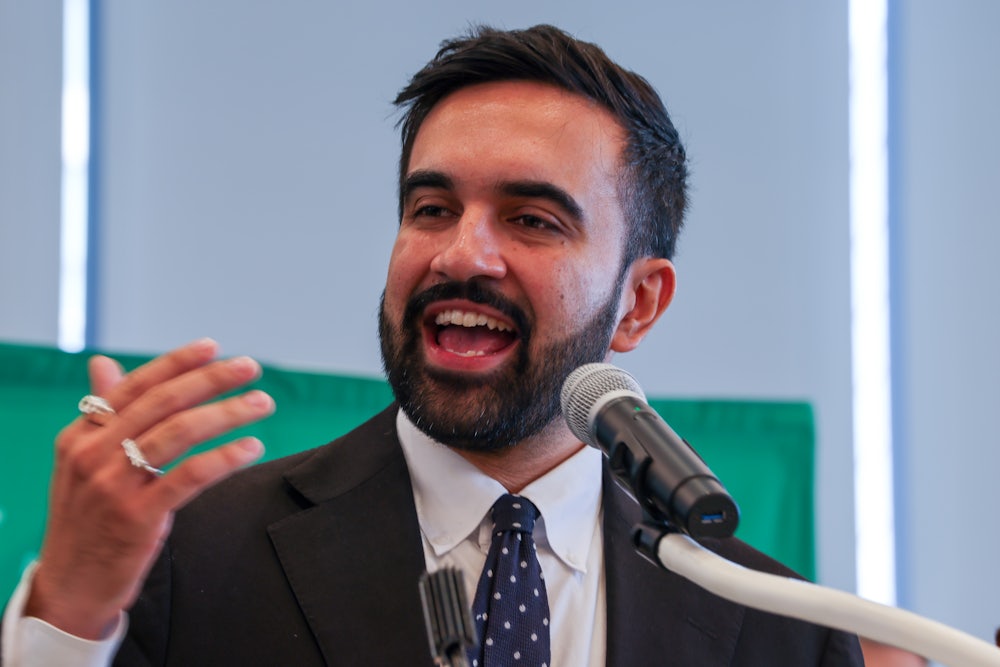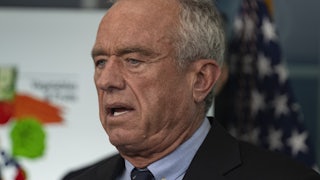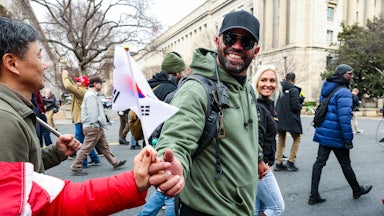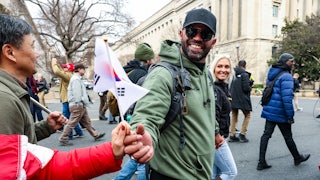Despite being mired in a cutthroat New York mayoral campaign, Zohran Mamdani recently released a video announcing that he was taking a vacation. A vacation, that is, in his childhood home of Uganda. In the video, he mocked right-wing trolls for telling him to go back to Africa and joked that his return there showed that he’s “listening” to those “critics.” He offered New York tabloids suggestions for headlines mocking his African heritage—one read “MIA? MAMDANI IN AFRICA”—and invited the tabs to feature them on their front pages.
As campaign messaging goes, this was unusual stuff. Yet the video has now racked up 4.5 million views on Instagram, according to internal campaign data supplied to me—and 56 percent of those were among people who weren’t following Mamdani on the messaging site.
Whatever happens in the mayoral race, Mamdani is already making a major contribution to a huge debate among national Democrats: over how to compete digitally in the age of Donald Trump. Much of this debate has turned on how to use paid digital spots in nontraditional ways and how to empower influential “Joe Rogan of the left” podcasters—or some other similar network—to achieve the penetration into the culture that matches whatever it is Trump achieved, which is elusive and hard to define.
But the Mamdani campaign seems to be achieving a version of this penetration with unpaid social media videos that communicate directly with voters. The goal is to achieve a kind of Trumpian ubiquity: Andrew Epstein, the campaign’s creative director, says it’s designed to ensure that if you are “on your phone,” you are “going to see Zohran.”
Internal campaign data on the reach of Mamdani videos—provided at my request—illustrates the point. All these went up after Mamdani won the Democratic primary by 12 points several weeks ago:
- A Mamdani video about sluggish traffic in Manhattan (not typically viral material) enjoyed 2.3 million views on Instagram, nearly 50 percent among nonfollowers.
- A video featuring Mamdani describing his primary win and ascribing it to his relentless focus on the “needs of working people” got 2.1 million Instagram views, nearly 55 percent among nonfollowers.
- A video featuring Mamdani getting endorsed by a Haitian American assemblywoman got 1.6 million Instagram views, over 43 percent of them nonfollowers.
“His campaign is earning these numbers because they’re putting digital practitioners in charge who understand what’s going to resonate online,” said Danielle Butterfield, executive director of Priorities USA, the super PAC charting new digital strategies for Democrats.
The party has long been overly reliant on issue testing and polling to make ads. But Butterfield notes that Mamdani’s approach is based on the intuition that “letting him speak authentically to what he believes” will “break through” on the internet, understood as an “entertainment and social vehicle” where the competition for eyeballs is relentless.
Tech writer Mike Masnick points to another telling sign: At least 10 of Mamdani’s recent videos have garnered over one million views on TikTok in particular. “To consistently pull really high numbers, even with wonky material, shows something is really working,” Masnick told me. “People spend a lot of time on short-form video apps looking to be entertained by real people. He’s been able to produce political content that meets that need.”
Consistency, as Masnick says, is the key here: All those numbers come after Mamdani’s Instagram content amassed 236 million views during the final month of the primary, per Politico.
In an intriguing way, Mamdani’s media strategy is deeply intertwined with his approaches to other conundrums gripping Democrats. Take the question of how to talk about issues like affordability and functional government, demonstrated in the video about Manhattan traffic:
The 14th Street Busway has been a smashing success: faster commutes, fewer crashes, calmer streets.
— Zohran Kwame Mamdani (@ZohranKMamdani) July 11, 2025
So why is Eric Adams blocking a similar plan for 34th Street? pic.twitter.com/X8hbVj00hy
Note Mamdani’s insistence on making “moving around our city safer, faster, and more enjoyable.” Emphasis mine: Much of Mamdani’s messaging is about fixing the government so it makes people’s daily lives more livable. The positive vibe that New Yorkers are fortunate to live in such a great city—and that it can be made even more awesome—suffuses everything.
At a time when Democrats are talking about the new “abundance” agenda from Ezra Klein and Derek Thompson—which would reform government to facilitate production of essential social goods—this messaging shows it’s possible to communicate about making government work in a concrete, accessible way that, critically, also works on social media.
Watch how Mamdani applies this to affordability in this well-known video on “halalflation”:
Chicken over rice now costs $10 or more.
— Zohran Kwame Mamdani (@ZohranKMamdani) January 13, 2025
It's time to make halal eight bucks again. pic.twitter.com/OJMdWb7lkr
What makes the affordability issue accessible here is the plain-language, can-do suggestion that it’s downstream of bad governing choices and bottlenecks that can be fixed. Klein recently suggested that Democrats can project authenticity and appeal by talking like an “angry moderate.” Contra that, Mamdani—who is also campaigning on tax hikes for the rich and making bus service free—offers what you might call “cheerful populism.”
Then there’s immigration. Watch the video of Mamdani getting endorsed by the Haitian American assemblywoman, Brooklyn Democratic Chair Rodneyse Bichotte Hermelyn:
Little Haiti is vibrant. And it’s facing the same cost of living crisis as neighborhoods across the city.
— Zohran Kwame Mamdani (@ZohranKMamdani) July 15, 2025
That's why @bkdems Chair @AMBichotte and I are bringing the Democratic Party together around a shared vision for an affordable New York. I am grateful for her endorsement! pic.twitter.com/JWiBPqjsz2
One underappreciated reason for Mamdani’s success thus far is that his campaign is overtly pro-immigrant. Mamdani teaching Hermeylan how to pronounce his name is standard New York sentimentality; a generation ago, city comptroller candidate Frank Macchiarola ran similar ads. But it works here because it’s authentic and captures contemporary New York.
An immigrant who naturalized in 2018, Mamdani’s outreach to other immigrant groups helped drive his primary win. He ran up big vote totals in neighborhoods with large Latino and South Asian populations.
Mamdani has of course opposed Trump’s immigration agenda, vowing to resist ICE raids as mayor, as this confrontation with Trump border czar Tom Homan shows:
Today I confronted “border czar” Tom Homan who came to Albany to do Trump’s bidding — push for mass deportations, carry out the assault on working class New Yorkers, and justify the unjustifiable detention of legal permanent resident and father-to-be, Mahmoud Khalil. pic.twitter.com/hPRQrB6Ci6
— Zohran Kwame Mamdani (@ZohranKMamdani) March 12, 2025
But there’s more to his pro-immigrant posture than this. Mamdani’s campaign goes out of its way to be affirmatively pro-pluralism and pro-cosmopolitanism.
This appears rooted in a particular understanding of the city. As John Ganz notes, all those attacks on Mamdani as an antisemite—he’s a Muslim who didn’t denounce the phrase “globalize the intifada”—failed to prove decisive partly because so many voters actively recoil at the fomenting of “ethnic hatreds” in New York. They love the city precisely because it demonstrates that it’s possible to maintain peaceful coexistence (admittedly not always successfully) even when events and demagogues threaten to incite ethnic strife.
Mamdani speaks directly to that deep impulse. When he and Brad Lander, the Jewish New York City comptroller, cross-endorsed each other in the city’s system of ranked-choice voting, Lander addressed Middle East violence by saying: “There is something quite remarkable about a Jewish New Yorker and a Muslim New Yorker coming together to say, ‘Here’s how we protect all New Yorkers.’”
In that regard, it’s worth appreciating how Mamdani’s communications sometimes show him and others talking while walking and eating—and while sharing food across ethnic lines. Anyone who has lived in New York knows that the ever-present option of strolling from one ethnic neighborhood to the next while sampling varied local fare is one of the city’s great bounties. When I asked the campaign’s Andrew Epstein what messaging role this eating and sharing of ethnic food plays, Epstein said it captures what’s essential about the man himself: “The generosity around food is so much of who he is.”
This affirmative cosmopolitanism is visible in the campaign’s broader media strategy, too. His aides point out that he regularly gives interviews to very obscure foreign-language media outlets. Among them: South Asian television, a Pakistani news channel, Punjabi TV, and a reporter for a Bangla newspaper.
“We are going to heavily feature him in these places throughout the fall,” Zara Rahim, a senior campaign adviser, told me. “When you say ‘freeze the rent’ or ‘free buses,’ it’s plain-spoken, and translates cleanly into every single language, lowering the barrier to entry for immigrant voters often dismissed as ‘low information.’” In this, the campaign’s emphases on affordability and pluralism and digital innovation all intersect.
The vibe to all this—the halal carts, the sidewalk-eating, the enjoyment of ethnic neighborhoods, the celebratory tone toward New York’s pluralist way of life—is a bit like what you might imagine localized patriotism in historical city-states looking like.
I don’t want to sound overly Pollyannaish. There are tons of caveats. The traffic and halalflation videos address relatively small, targeted problems—Mamdani will have to demonstrate that this mode of intimate appeal can effectively communicate bigger solutions and a bigger vision.
Mamdani will also have to spend many millions on traditional TV as many voters remain hard to access digitally. He will face an onslaught of TV ads depicting him as untested, soft, lacking in executive experience, and friendly to terrorists. He will need to appeal to a broader general election coalition involving older New York constituencies like working-class Blacks and outer-borough whites. He will need to reassure additional persuadable Jewish voters.
Mamdani knows all this: He has qualified his “intifada” stance and he’s expected to amplify his pledge not to defund the police. And as Mara Gay details, he’s explicitly pitching “affordability” as the thing that unites New Yorkers across ideological lines.
Obviously, not every Democrat can emulate Mamdani’s charisma and political talents, which drive his digital success. But Mamdani’s real innovation isn’t just personal. It lies in the deliberate fusion of personal appeals with substantive ones. He has figured out how to make talk about community boards and city council bills go viral by being a dude you want to hang out with and get to know better on social media. As Epstein told me, what’s critical is the combination of “demonstrating a positive agenda that improves people’s lives” while putting “this full person front and center.”
Win or lose, his campaign will have much to teach Democrats. If politics is ultimately about communicating in appealing ways, Mamdani is both charting a new way forward for the digital era while also getting back to basics at the most fundamental level of all.






